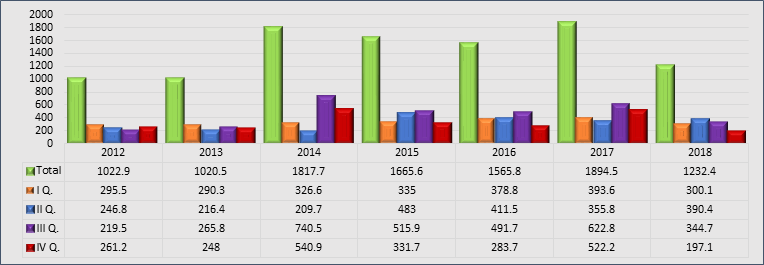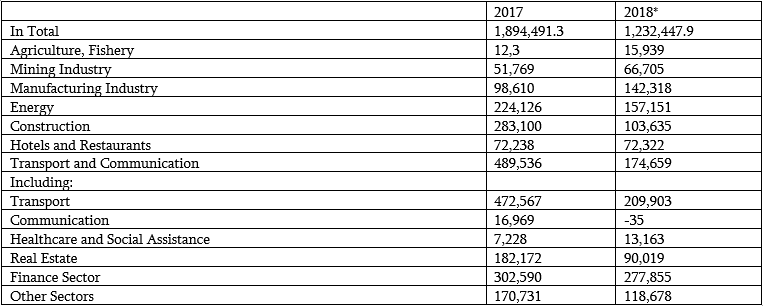Resume: A total of USD 1.23 billion in foreign direct investments were made to Georgia in 2019 which is USD 662 million (35%) less as compared to the previous year and the lowest since 2013. In terms of investments per quarters, QIV of 2018 is the lowest since QI of 2010. In addition, six of the ten main investment sectors experienced a decline in investments whilst there is only a slight growth in other sectors. Therefore, we are facing a systemic problem and Mamuka Bakhtadze’s statement that there is no dynamic of decreasing foreign direct investments is inaccurate.
Of the main components behind the decreased FDI, there is the completion of the BP gas pipeline construction project which has been ongoing in the previous periods and positively affected the volume of investments in the past years. Simultaneously, several enterprises are now owned by Georgian residents and, therefore, these enterprises are no longer categorised as foreign investments. Therefore, Mamuka Bakhtadze’s statement has some elements of truth in this part. However, of note is that the reinvestment[1] figure decreased by USD 98 million as compared to 2017.
The Government of Georgia’s representatives offer only “technical” aspects (debt service, BP pipeline project completion) as counter-arguments vis-à-vis the dynamic of investment decrease and which are of a speculative nature. Usually, when FDI increased in the previous years, no one emphasised such details. Of additional importance is to note that a part of the investments previously left the country (debts were served, companies were sold). However, this outflow was balanced by other inflows, something which did not happen this year. Therefore, pointing out technical reasons does not free the Government of Georgia from its responsibility.
Analysis
In response to a question asked about decreased foreign direct investments, the Prime Minister of Georgia, Mamuka Bakhtadze, stated (from 22:00): “The half-billion dollar difference between the FDI of 2017 and 2018 is caused by the completion of the gas pipeline, Georgian residents purchasing shares from foreign residents and paying their obligations. Therefore, we are not facing a trend nor a dynamic of decreasing foreign direct investments.”
In accordance with the National Statistics Office of Georgia, USD 1.23 billion in investments were made to Georgia in 2018 which is USD 662 million (35%) less as compared to 2017. This volume of FDI is the lowest since 2013. The investment figure of QIV of 2018 is the lowest since QI of 2010.
Graph 1: Foreign Direct Investments in 2012-2018 (USD Million)

Source: National Statistics Office of Georgia
Of the ten main investment sectors, investments have decreased in six of them: energy, construction, transport, communication, real estate, finance and other categories.[1] In addition, there is a negligible growth in the hotels and restaurants sector with this increase constituting only USD 84,000. Therefore, we are facing a systemic problem. Mamuka Bakhtadze’s statement that there is no dynamic of decreasing foreign direct investment does not illustrate the realities on the ground.
Table 1: Foreign Direct Investments in Terms of Sectors (USD Thousand)

Source: National Statistics Office of Georgia
Part of the reasons which the Prime Minister named as stipulating the decline in foreign direct investments is in line with the report of the National Statistics Office of Georgia. In accordance with this report, the main reasons behind the decreased foreign direct investments are the completion of the gas pipeline construction project and moving several enterprises under the ownership of Georgian residents. In addition, the reasons also include decreased obligations (that is, serving debts) vis-à-vis non-resident direct investors. However, of note is that the reinvestment figure dropped by USD 98 million as compared to 2017 which is also a problematic issue although Mamuka Bakhtadze has not mentioned this fact.
Of further importance is to note that the authorities offer a variety of technical reasons, such as debt service, BP gas pipeline’s economic essence, etc., as counter-arguments to the decrease in investment although these arguments seem to be of a speculative nature. When the FDI was growing in the previous years, no one paid attention to such details.
The FDI figures fluctuated significantly in 2013-2018. Therefore, it is hard to identify a certain trend and, in this case, the use of cursive modelling is not appropriate. Graph 2 depicts the trend from the so-called polynomial modelling which relatively better illustrates the trend of fluctuating figures. This trend is not clear-cut and the initial growth is followed by a later decline. The authorities do not attach great importance or consider it a problem that this part of FDI has decreased. In this case, it is unclear why the authorities proclaimed a large amount of FDIs in the past as a success because those large numbers were partially stipulated by the aforementioned components as well. Of important note is that investments have previously also left the country (debts were served, companies sold) but that outflow was balanced by other inflows, something which did not happen this year.
Graph 2: Foreign Direct Investment Outflow (USD Million) Trend in 2013-2018

Source: National Statistics Office of Georgia
[1] Difference between the profit and the distributed dividend. Dividend is part of profit which has to be distributed among investors
[2] Trade and education as well as communal, social and personal services








